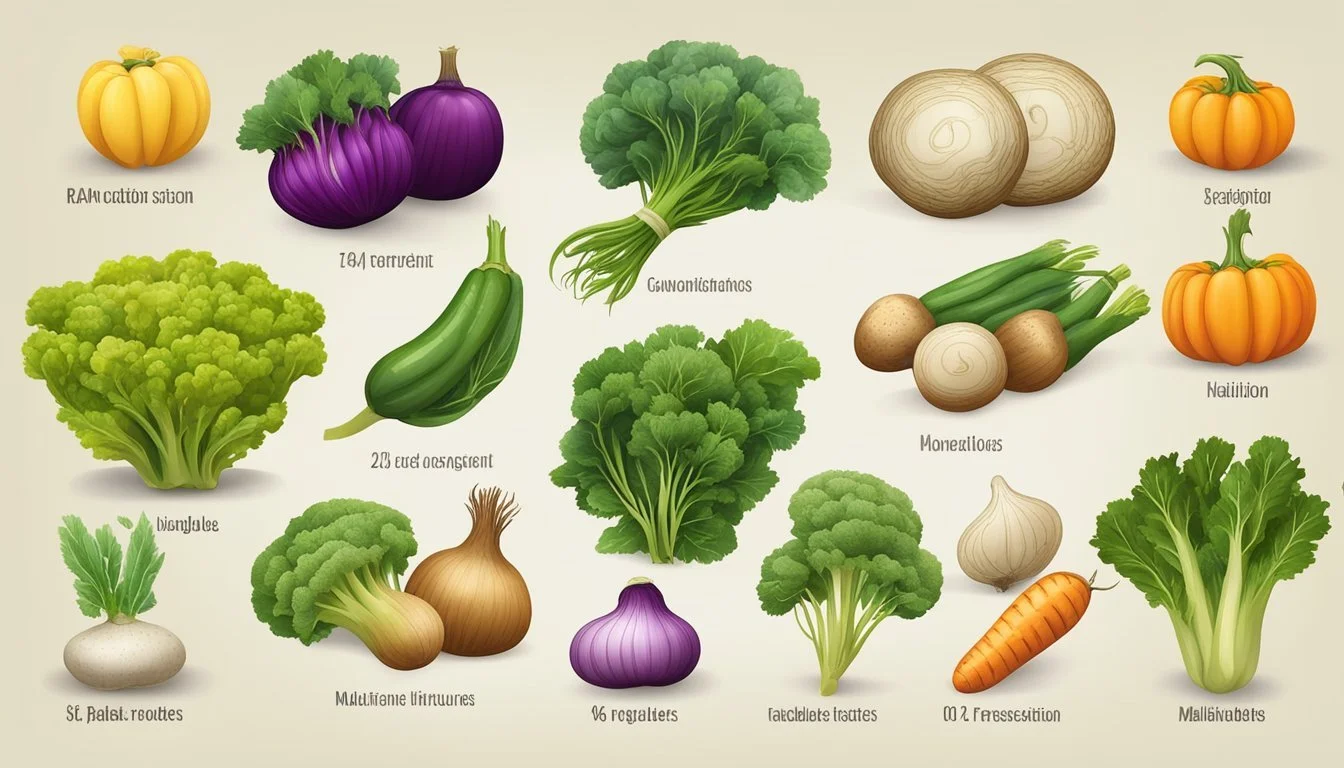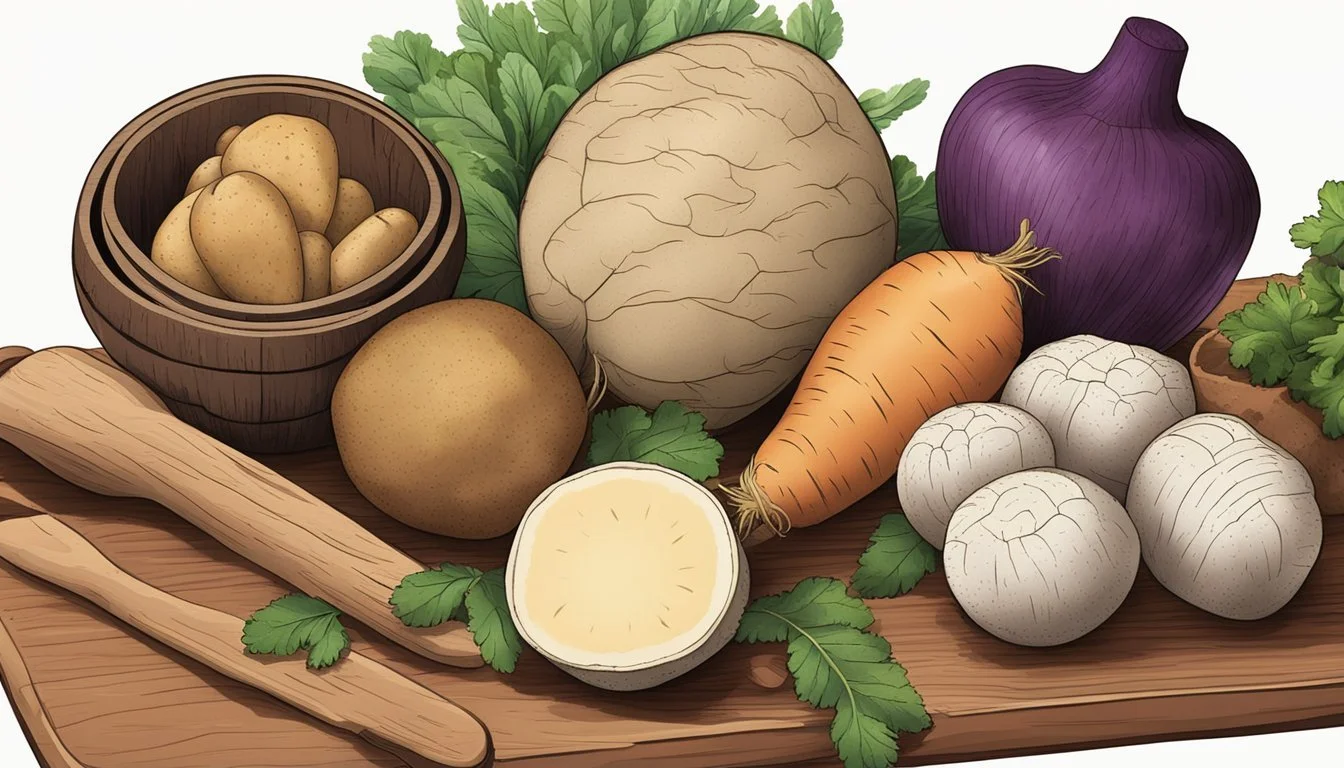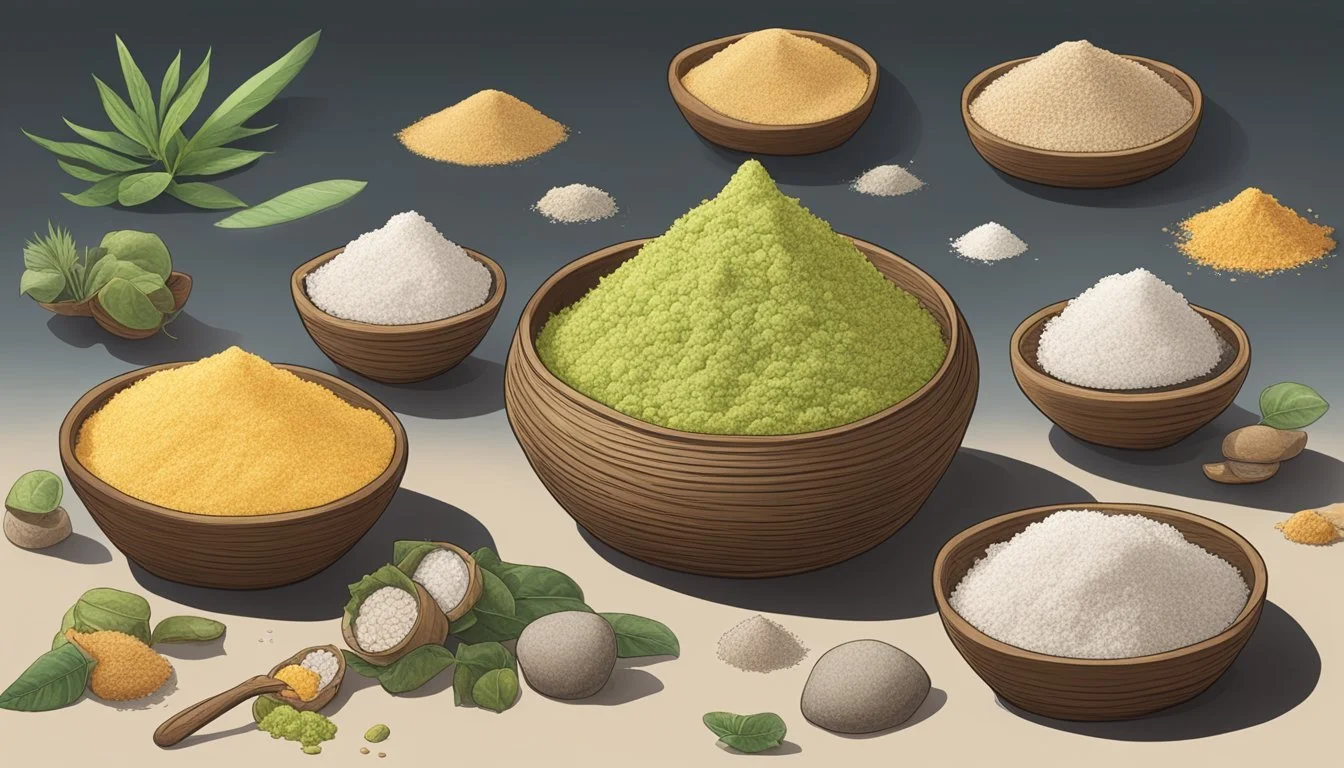Malanga Substitutes
Top Alternatives for Your Recipes
For those seeking to diversify their culinary experience or need a nightshade-free alternative, malanga serves as an excellent substitute for traditional potatoes. Native to tropical America, malanga offers a starchy, savory profile that can seamlessly replace potatoes in various dishes. Its versatility allows for numerous preparation methods, including boiling, mashing, and frying, providing a broad range of textures and flavors to enjoy.
Malanga's unique characteristics make it an appealing option for those with specific dietary needs. As it crisps up nicely when fried and maintains a satisfying texture when mashed, it's a valuable ingredient in gluten-free and autoimmune paleo recipes. Additionally, malanga's ability to naturally thicken soups and broths adds another layer of functionality for home cooks looking to experiment.
Furthermore, understanding how malanga compares to other root vegetables like taro and yuca can enhance its application in cooking. While it shares similarities with these roots, minor differences in texture and flavor can influence the final dish, making malanga a distinctive choice worth exploring. This exploration offers a new dimension to traditional recipes, broadening culinary horizons and accommodating dietary restrictions without compromising on taste.
Understanding Malanga
Malanga is a versatile root vegetable originating from tropical regions. It is rich in essential nutrients and has a variety of culinary applications, making it a popular choice in many kitchens.
Origin and Cultivation
Malanga is native to Central and South America, Africa, and the Caribbean, including Cuba and Puerto Rico. It grows from the base of the malanga plant, producing a tuber with a thick, shaggy skin. This plant thrives in tropical climates with warm, humid conditions and well-drained soil. The cultivation process requires regular watering and a nutrient-rich environment to ensure healthy growth. Malanga can be harvested when the plant's leaves turn yellow, usually after 10-12 months of growth.
Nutritional Profile
Malanga is packed with important nutrients. It is particularly rich in dietary fiber, which aids in digestion and helps maintain a healthy gut. Additionally, malanga contains significant levels of potassium and vitamin C, both crucial for cardiovascular health and immune system function. Unlike many other root vegetables, malanga is low in fat, making it an excellent option for those on a low-fat diet.
NUTRITION TABLE:
Dietary Fiber: High
Fat: Low
Potassium: High
Vitamin C: High
Culinary Uses
Malanga can be prepared in various ways, providing different textures and flavors. Commonly, it is peeled and then boiled, mashed, or deep-fried into chips. The flesh tends to disintegrate when cooked, making it ideal for creamy soups and purees. It can also be used as a nightshade-free substitute for potatoes in dishes like mashed faux-tatoes, stews, and hashbrowns. Its versatility allows for incorporation into diverse cuisines, from Caribbean to Asian-inspired recipes.
Health Considerations
Malanga offers several health benefits such as being high in fiber and essential nutrients. However, it can also pose potential allergens or irritants, so it is important to handle and prepare it correctly.
Dietary Benefits
Malanga is rich in fiber, which supports digestive health and can help maintain regular bowel movements. Because it is naturally gluten-free, it is suitable for those with celiac disease or gluten intolerance.
Its nutrient profile includes vitamins and minerals like potassium, which is beneficial for maintaining heart health by regulating blood pressure. Additionally, malanga is often used in paleo diets due to its nutritional benefits and non-starchy nature.
Another advantage is its versatility; it can be mashed, boiled, or fried, making it an excellent substitute for potatoes while enjoying various dishes.
Potential Allergens and Irritants
While malanga is typically safe for most people, it can cause skin irritation during preparation. It is advised to wear gloves when peeling and chopping to avoid any skin reactions.
Some individuals may experience allergic responses, though such instances are rare. Ensuring that malanga is cooked properly can help avoid food-borne diseases that are sometimes associated with undercooked root vegetables.
Furthermore, it's important to rinse and clean malanga thoroughly to remove any potential contaminants that may irritate the digestive system. Proper hygiene and cooking methods can mitigate most of these risks.
Popular Malanga Substitutes
Malanga is a versatile root vegetable often used in various recipes. There are several suitable substitutes for malanga that can work for different culinary needs. Here, we explore common alternatives like taro root, potatoes and sweet potatoes, yuca (cassava), and other root vegetables.
Taro Root
Taro root is a tropical tuber similar in appearance and texture to malanga. Its starchy nature makes it an excellent substitute in dishes like stews, soups, and mashes. Taro has a slightly nutty flavor, providing a unique taste while maintaining a similar consistency to malanga. It's important to note that taro must be cooked thoroughly to remove natural toxins.
Potatoes and Sweet Potatoes
Potatoes are the most common substitute for malanga due to their widespread availability and versatility. They can be mashed, boiled, fried, or baked. Sweet potatoes provide an additional twist with their natural sweetness and high beta-carotene content. Both of these options are suitable for a variety of dishes, whether savory or slightly sweet.
Yuca (Cassava)
Yuca, also known as cassava, is a starchy root that is a staple in many tropical regions. It can be used in similar ways to malanga, like boiling, frying, or baking. Yuca must be peeled and cooked thoroughly to eliminate any cyanogenic compounds that can be harmful if consumed raw. Its texture is denser than potatoes, making it ideal for robust dishes.
Other Root Vegetables
Other root vegetables like plantains, parsnips, and cauliflower serve as good substitutes for malanga depending on the recipe. Plantains can be used in both sweet and savory dishes, especially when fried. Parsnips offer a slightly sweet flavor and can be mashed or roasted. Cauliflower provides a low-carb option, often used to make cauliflower "mashed potatoes" which can mimic the texture of malanga in certain dishes.
Each of these substitutes offers unique benefits and can be selected based on the recipe's requirements and desired flavor profile.
Preparing Substitutes
When preparing substitutes for malanga, techniques like boiling, mashing, roasting, and baking ensure a versatile and flavorful outcome, suiting a variety of palates and dietary needs.
Boiling and Mashing
Boiling is the first step to making a smooth mash. Begin by peeling the substitute roots, such as taro or yuca, and cutting them into 2-inch chunks.
Place the chunks in a pot of filtered water and bring to a boil. Reduce the heat to a simmer and cook for about 25 minutes or until the pieces are tender and easily pierced with a fork.
Drain the water and mash the pieces using a fork, potato masher, or an immersion blender until smooth.
For added richness, incorporate butter or ghee into the mashed mix. The substitute can be used in various recipes, offering a creamy texture with a hint of nutty flavor from the roots.
Roasting and Baking
Roasting and baking provide an alternative to boiling and mashing, enhancing the substitutes' natural flavors. Preheat your oven to 400°F (200°C).
Peel and cut the roots into evenly sized wedges or cubes. Toss them in a bowl with olive oil, salt, and pepper.
Arrange them in a single layer on a baking sheet lined with parchment paper. Roast for 25-30 minutes, turning halfway through, until they are golden brown and crispy on the outside.
This method brings out a distinct, nutty flavor and a pleasing texture, making it an excellent addition to various dishes.
Recipes and Adaptations
Malanga is a versatile root vegetable that can be used in various culinary applications. Its ability to retain shape when cooked and its compatibility with both savory and sweet dishes make it an excellent substitute for potatoes in many recipes.
Soups and Stews
Malanga works well in soups and stews due to its firm texture and ability to thicken broths. It can be diced and added to a sancocho, a traditional Caribbean stew, where it mingles with other vegetables and meats. For a creamy soup, malanga can be blended after boiling to create a silky poi. Gloves are recommended when peeling to prevent skin irritation.
Fried and Baked Dishes
Malanga is excellent for fried and baked dishes. Malanga fritters are a popular snack, where grated malanga is mixed with spices and deep-fried until crispy. It can also be sliced thin and made into chips. Baked malanga can be used in shepherd's pie instead of potatoes, providing a unique twist on the classic dish.
Innovative Uses
Beyond traditional recipes, malanga offers innovative uses. Its hearty texture makes it suitable for creative dishes like hash browns or malanga-based gnocchi. Frying brings out its nutty flavor, making it enjoyable as crispy AIP hashbrowns. Try combining mashed malanga with other roots like taro or yuca for an interesting blend in baked casseroles.
Comparative Advantages
Malanga and its substitutes, such as taro and yuca, offer unique attributes. They differ in flavor, texture, versatility in cooking, and nutritional benefits, making them suitable for various dietary needs and culinary applications.
Flavor and Texture
Malanga has a distinct earthy flavor with a hint of nuttiness. Its texture is starchy and fibrous, making it an excellent potato substitute.
Taro offers a mildly sweet taste and a creamy texture when cooked, which enhances desserts and savory dishes alike.
Yuca (or cassava) delivers a subtle, slightly nutty flavor, with a dense and chewy texture after cooking.
In essence, malanga brings a unique combination of flavors and textures, together with taro and yuca, adapting well to different culinary environments.
Versatility in Cooking
Malanga is versatile, suitable for boiling, frying, baking, and mashing. It holds up well in stews and soups, retaining its structure and providing a unique taste profile.
Taro is similarly adaptable, often used in sweet and savory recipes. It excels in baking, desserts, and savory dishes like soups and stir-fries.
Yuca shines in fried and baked applications. It can be turned into fries, chips, and even used in bread and cakes.
This versatility ensures that each of these roots can seamlessly integrate into a variety of culinary traditions.
Nutritional Comparison
Malanga offers high fiber content, promoting digestive health. It is also rich in vitamins and minerals, including vitamin C and B vitamins.
Taro provides similar nutritional benefits, with a lower glycemic index, making it suitable for individuals needing to manage blood sugar levels. It contains vitamins E and C, along with a robust mineral profile.
Yuca, while also nutrient-dense, is particularly high in vitamin C and manganese. It delivers ample energy due to its carbohydrate content but should be consumed in moderation to manage caloric intake.
Comparatively, all three roots supply valuable nutrients, supporting varied dietary needs while offering unique flavors and textures.
Practical Tips
Properly using malanga substitutes involves understanding storage and selecting the right alternative for your specific culinary application. Here are practical tips to help you.
Storage and Preservation
Store malanga, taro, and yuca in a cool, dry place, preferably in a ventilated basket. Refrigerating these roots can extend their shelf life by a few days but may alter their texture.
To freeze, peel and cut the roots into manageable pieces. Blanch them briefly in boiling water, cool quickly, and store in an airtight container. This method preserves the flavor and reduces prep time for future use.
Keep these roots in sealed containers to prevent moisture buildup and potential mold growth. Proper storage ensures they remain fresh and suitable for various cooking methods, such as boiling, mashing, or frying.
Choosing the Right Substitute
Choosing between malanga, taro, and yuca depends on the desired texture and flavor. Malanga is firmer and drier, ideal for recipes requiring structure, like fritters or chips.
Taro, known for its softer texture, works well in purees and soups, creating a smoother consistency.
Yuca has a starchy, slightly sweet taste and is versatile in both savory and sweet dishes. It retains shape well in boiling, making it excellent for stews.
Always match your substitute choice to the specific requirements of the recipe. Consider the cooking method and final dish texture to achieve the best culinary results.
Cautions and Recommendations
Malanga is a versatile and nutritious root vegetable, but there are crucial considerations to keep in mind.
Toxicity and Adverse Reactions
Malanga must be cooked properly before consumption. Eating it raw can lead to toxic and adverse reactions. Ensure it is thoroughly peeled and cooked to avoid any potential issues.
Food Poisoning
Improper storage and handling can lead to contamination and food poisoning. Store malanga in a cool, dry place and always clean it thoroughly before cooking.
Medical Advice
Individuals with specific dietary needs or health conditions should consult a qualified medical practitioner before incorporating malanga into their diet. This is particularly important for those with allergies or sensitivities.
General Recommendations
Peel Carefully: Remove all brown skin as it can be tough and unpleasant.
Cook Properly: Boil, mash, or fry to ensure it's safe to eat.
Store Correctly: Keep in a cool, dry place to prevent spoilage.
Always follow privacy policies of any online resources when seeking additional information about malanga or related health advice.








